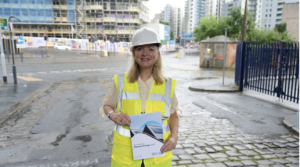How to collaborate
With less resources around the onus is on organisations to work together. Alison Chambers explains how to ensure things click into place

A workshop run by Community Action Southwark. The organisation was created following the merger of Southwark Community Care Forum and Southwark Action for Voluntary Organisations in 2008
Working together strengthens the power of individuals, organisations and communities at a local neighbourhood level. By collaborating communities can create a critical mass to challenge, influence and participate confidently in local decision making and service delivery.
But collaborative working is not always easy: there is a spectrum of approaches, motivations and outcomes, and often it is the people and power dynamics that can determine whether a collaborative venture succeeds or fails.
How to Support… Collaboration for Communities: Giving Power to Partnership, produced by Bassac, a membership body for community organisations, is a new resource for independent facilitators of collaborations.
Such people can work with individuals and organisations, acting as an ‘honest broker’ and a neutral facilitator who can challenge assumptions, help to clarify purpose and keep the collaboration on track.
These people require a wide range of skills and knowledge to navigate some of these complexities.
The guide draws on the learning from Bassac’s involvement in the Collaboration Benefits programme. For many years, Bassac has supported its members and the wider community sector to initiate and engage in collaborative working.
The Collaboration Benefits project was created to identify effective models of support, to enable access to useful resources and, crucially, to learn from, develop and disseminate skills in supporting collaborative working.
We’ve brought together all our learning from supporting collaborative working and training people to support collaborations to create this free publication. It’s a comprehensive guide for anyone in a position to support collaboration involving community and voluntary groups.
In this article we draw on the guide to explore the challenges involved in organisations working together, the common pitfalls to avoid and ways to ensure the process runs as smoothly as possible.
First things first, why collaborate? We have developed the following set of aims that are key to ensuring there is a shared understanding of the added value that a partnership can bring; these underpin not only the collaboration but also any support given. They are to:
• Reduce costs
• Increase and/or diversify income
• Increase influence (raising public profile)
• Improve the use of resources (building, staffing, ICT, equipment, skills etc)
• Reduce duplication of services
• Improve coordination of services
There is currently an increasing interest in a broad range of collaborative working arrangements across the voluntary and community sector. The shift from grant funding to contracts, commissioning and procurement, the aggregation and greatly increased sizes of available contracts, and the commonplace requirement from funders to provide services in partnership have become incentives to collaboration. Government policy continues to highlight the importance of the engagement and involvement of the sector in both shaping and delivering public services.
The new context of reduced funding and cuts means that community and voluntary organisations are actively seeking innovative ways to provide services that respond to local need, to develop partnership bids, form consortia, share buildings and back office services.
There are a range of opportunities and challenges for the voluntary and community sector and now more than ever Bassac believes it is through collaboration that communities can take control and lead new innovative models for service delivery such as the development of mutuals and different forms of cooperative and collective ownership.
ESTABLISHING THE RELATIONSHIP AND PLANNING SUPPORT
The beginning of the process of supporting a collaboration is quite intensive. The facilitator will need to find out about the organisations they’re working with so that they can provide effective support. Buy-in from crucial people such as senior managers, users and trustees will need to be developed and expectations will need to be looked at and established. At the start, the facilitator of the collaboration needs to clarify their role, responsibilities, accountabilities and the level and type of confidentiality that’s expected.
The next step is to create a support plan which will serve as a guide for all those involved in the collaboration. Later this plan may need to be changed or even abandoned, but it’s helpful to map out the steps that need to happen to create or improve collaborative working.
Facilitating a collaboration is essentially facilitating part of a strategic planning process. It will inevitably involve change, which can be challenging for those involved. The ‘How to…’ guide explains group theory, helping facilitators understand that groups often need to go through a difficult phase to reach agreement.
MANAGING THE SUPPORT PROCESS
Developing a shared purpose, a clear vision and a strategic plan is arguably the most important area for support when it comes to developing partnerships.
Many partnerships struggle with this task, but an unclear purpose and vision of what the collaboration is trying to achieve will inevitably derail progress. Well-established partnerships may also need support with this.
Partners need to agree on their organisational aims and their aims for the collaboration. Much of the potential for future conflict lies in the detail, so it’s important that this is negotiated and agreed at an early stage.
The guide contains several exercises to help create a partnership strategy. They help the organisations involved to identify key stakeholders, assess the operating environment and think through the consequences of continuing, starting or stopping the collaboration.
The exercises also suggest ways to analyse costs and benefits and to identify possible risks. Establishing the business case for working in partnership is central to the strategic planning process and underpins the partnership strategy. The business case should demonstrate evidence of the potential efficiency savings which may be achieved by working collaboratively, leading to better service provision.
WHAT TO CONSIDER
During the process of supporting a collaboration a facilitator will need to consider the following:
• Options – a consideration of the range of options available to address perceived issues, both for each partner organisation (where collaboration may be one of a series of options) and for the partnership as a whole
• Evidence – for the above in both cases
• Resources required – financial resources and time, in relation to both the organisation and the partnership
• Benefits – to service users of each organisation, and the collaborative advantage identified: what can be achieved collectively that couldn’t be achieved independently?
BUILDING AN OUTCOME FRAMEWORK
Partnerships should build a framework into their strategic planning process, gathering baseline information on any performance indicators at the start of the collaborative project so that it’s possible to gauge progress.
For example, if the aim is to reduce costs, what are the current costs? If it is to increase influence, what happens at the moment in terms of how users’ views are being represented, and to whom?
It’s likely that the partners began collaborating before a facilitator got involved; they may have to check back to where they thought they were at the start. On the other hand, it may be just as useful to do an assessment of the current situation.
DEVELOPING A WAY FORWARD
The ‘How to…’ guide also provides a framework for developing partnership agreements and memoranda of understanding. These are written descriptions of roles and responsibilities in relation to specific arrangements.
There is unlikely to be a specimen document that can be pulled off the shelf and applied to the partnership without careful negotiation and some modification and partners will need to discuss and agree each point before signing it off.
Having clear roles and responsibilities is a key component of effective collaboration. Partners should understand what roles are important to make their partnership function well in the context of what they plan to do. Tools are included in the ‘How to’ guide to help partners explore and agree roles and responsibilities within the collaboration.
The organisational culture – or the ‘personality’ of an organisation – can be hard to define but is nonetheless important to understand when supporting collaboration.
Usually, organisational culture is expressed in terms of values, assumptions and norms of behaviour. Even organisations that look similar from an outsider’s perspective demonstrate considerable cultural differences.
The extent to which this needs to be explored depends on the nature of the collaboration. In the case of a potential merger, reconciling different cultures is critical to the merger’s success. Where less formal collaborations are concerned it can be useful simply to set some ground rules about behaviours.
Flexibility around different approaches can help. Larger or lead organisations should not try to impose their own systems on other partners. Instead, the partnership should develop approaches and systems which are appropriate to the partnership and agreed by all.
DEALING WITH CONFLICT AND BUILDING RELATIONSHIPS
This is a critical aspect of collaborative working: collaborations can succeed or fail depending on relationships between partners. Clarity of purpose, clear roles and responsibilities, and agreed procedures will help develop stronger relationships.
The facilitator’s role here is to ensure that problems in the way the partnership operates are not obstructing effective working relationships. They may find that the problem the partnership presents as being the highest priority is masking another problem that needs dealing with first. The facilitator can play a valuable role as a neutral, honest broker.
CONCLUDING AND EVALUATING YOUR SUPPORT
The way in which the facilitator’s relationship with those involved in the collaboration is ended is very important.
Depending on what has been agreed with the collaboration, the conclusion of the support may come at the end of an agreed amount of time; after the completion of a specific piece of work; or for other reasons. Ideally the ‘exit’ of the supporter will have been planned at the beginning of the relationship and some kind of evaluation process will have been agreed.
An ending should enable the collaboration to reflect on how they have used and benefited from the support, understand the critical success factors that have enabled them to move forward, understand the barriers that may hinder progress in the future and have access to information on where they might find further support and information if needed.
It’s also a good opportunity for the facilitator to reflect on their practice and to develop their understanding of what works.
——————————————————
The balancing act involved in merger talks
Unsurprisingly, I’ve been getting more requests for facilitating merger negotiations than any other types of referral – a marked change from two years ago when they were fairly uncommon. In the following example, the two organisations decided not to merge, at least not for the foreseeable future.
The support started with a meeting with the two CEOs, who gave me some fairly detailed information on the history of both organisations and their track record of working collaboratively. I felt it was important to meet with both so that I was not seen to be working on behalf of any one organisation – my commitment being to the process and the best outcome for all concerned. I also stressed that I did not intend to take a position on whether the proposed merger was a ‘good thing’.
It was agreed at this meeting that it would be useful to conduct some interviews with staff and trustees from both organisations to help further understand potential benefits and perceived obstacles in making the business case. Although the initial contact had been from the CEOs, the trustees needed to ‘lead’ the process and make the final decision.
I used a structured set of questions and met with some individuals and groups from each organisation. This wouldn’t always be an appropriate way forward; but in this case as both organisations are user-led and have considerable involvement of users at all levels, it was felt that it was important. As an independent facilitator and with guaranteed confidentiality and anonymity, what came out of these interviews was a very open and honest view on the proposed merger. And what was also noticeable was how prepared people were to put their own personal issues to one side.
I used all this information to write up a report with some key recommendations and options for consideration. Some of the assumptions that had been made in the past that had indicated a merger might be a viable option were seriously challenged, and these came as quite a surprise to some people.
Negotiations were temporarily suspended while the issues raised were dealt with. Feelings were running fairly high at this point and it was easy to see how this could have deteriorated, souring what had been fairly reasonable relationships up to this point.
The issues were dealt with as far as possible at joint meetings to give both parties an opportunity to explain further the issues that had been raised. My role as ‘mediator’ and independent facilitator was crucial at this point.
In time, what came out of this process was a thoughtful consideration of the issues with an outcome (not to merge) that was understood and accepted by both organisation; when examined carefully the ‘business case’ just didn’t stack up. The information gained wasn’t wasted. It was used to develop some protocols for joint working that are being used to underpin further collaborative work.
———————————-
What do you do when conflict threatens to derail partnership talks?
I was asked to help with a collaboration that was clearly struggling; and at the first ‘scoping’ meeting, it was evident that relationships within the partnership were very poor.
Much of it seemed to focus on various people not pulling their weight – not turning up for meetings and then complaining about lack of progress. I put together a very brief questionnaire that could be filled in online asking partners to evaluate how successful the partnership had been in delivering against certain objectives.
What followed was rather a surprise – to me as well as the partnership. It came to light that at various different times at least three sets of aims and objectives were in circulation. And some individuals didn’t recall seeing any of these!
We then had a shared session where the aims of the collaboration were revisited. At this session there were widely different expectations about what the partnership might deliver. It wasn’t helped by the fact that the partnership had a paid coordinator who was employed by one organisation, supervised by another and located in yet another.
My role in this case included providing a reality check against what was feasible in terms of objectives and suggesting a clearer reporting structure.
One obstacle to progress was a controlling chair who tended towards behaving like a rather fierce parent. This made everyone else behave like badly behaved children! I did some coaching sessions with him that focused on how more ‘adult’ behaviour tends to create a similar response in others. He realised that by having certain expectations that others would deliver in a responsible manner he could create a more appropriate standard of behaviour.
In this case a clear set of aims and objectives that were achievable and realistic and a shared understanding of partners’ roles and responsibilities, coupled with a chair that was prepared to examine how he was influencing behaviours, helped to address much of the conflict that had been evident previously.
THE PRINCIPLES OF COLLABORATION
1. Collaborative working is essentially an arrangement that should enable those taking part to deliver their mission more effectively and make service improvements.
2. There need to be clear and measurable benefits desired by each organisation that will lead to service improvements. These benefits are not necessarily the same for each partner, but should be acknowledged and understood by all.
3. Collaboration aims will relate to a shared operational activity, delivered on behalf of the collaborating group.
4. The partnership must develop and set a strategic direction for its shared operations in order to deliver individual service improvements for all partners.
5. An organisation needs to satisfy itself that the benefits are worth the investment in the collaboration and are in line with its mission.
* Alison Chamber is cluster manager at Bassac. The How to Support… Collaboration for Communities: Giving Power to Partnership guide is packed full of tools, advice and quotes from supporters of collaboration. You can download a free copy and other useful guides and case studies at bassac.org.uk/collaborationbenefits
To request a hard copy of the guide please contact Joanna Shardlow















